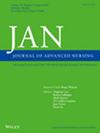Framing the Multi-Centre Qualitative Research Design as a Novel Methodology for Nursing and Healthcare Research: Reflections and A Methodological Discussion.
IF 3.8
3区 医学
Q1 NURSING
引用次数: 0
Abstract
AIM To discuss the multi-centre qualitative methodology as a unique design, articulate its guiding paradigm/theoretical perspectives, and highlight its methodological and methodical issues. A secondary objective is to generate further scholarly discourse regarding the multi-centre approach within the broader qualitative research tradition. DESIGN Methodological discussion. FINDINGS Rather than an emphasis on only experiences, the multi-centre approach is presented as a unique design which also focuses on uncovering why a phenomenon or problem exists and perceptions regarding the phenomenon/problem. With its focus on capturing multiple subjective realities, the multi-centre qualitative design is arguably underpinned by pragmatist constructivism which offers a robust framework for researching phenomenon in a way that is both theoretically informed and practically relevant. Methodologically, the multi-centre qualitative research design emphasises a problem-centred enquiry, collaborative approach and rigorous study protocols, systematic site selection, contextual immersion and sensitivity and methodical flexibility. CONCLUSION With the rapidly evolving nursing and global health landscape, the multi-centre design lends itself to exploring and capturing perceptions on a larger scale compared to single site studies. Careful planning, availability of adequate resources, rigorous protocols and quality assurance plans are critical to ensuring its success. IMPLICATIONS FOR PROFESSION AND PATIENT CARE The multi-centre approach offers the possibility of undertaking the same study across multiple settings/locations which has the potential to improve representation and strengthen transferability. IMPACT This methodological discussion offers clarity regarding the use of the multi-centre approach and offering strategies for its subsequent uptake in nursing and healthcare research. REPORTING METHOD Not applicable. PATIENT AND PUBLIC CONTRIBUTION No patient or public contribution.将多中心定性研究设计作为护理和医疗保健研究的新方法:思考与方法论讨论》。
目的讨论作为一种独特设计的多中心定性方法,阐明其指导范式/理论观点,并强调其方法论和方法问题。次要目标是在更广泛的定性研究传统中,就多中心方法展开进一步的学术讨论。 研究结果多中心方法并非只强调经验,而是作为一种独特的设计提出来的,它还侧重于揭示现象或问题存在的原因以及对现象/问题的看法。多中心定性设计侧重于捕捉多种主观现实,可以说是以实用主义建构主义为基础的,它为以一种既有理论依据又切合实际的方式研究现象提供了一个强有力的框架。在方法论上,多中心定性研究设计强调以问题为中心的探究、合作方法和严格的研究协议、系统的研究地点选择、环境沉浸、敏感性和方法灵活性。精心策划、提供充足的资源、严格的方案和质量保证计划是确保其成功的关键。 对专业和患者护理的启示多中心方法提供了在多个环境/地点开展相同研究的可能性,这有可能提高代表性和加强可转移性。影响本方法论讨论明确了多中心方法的使用,并为今后在护理和医疗保健研究中采用该方法提供了策略。
本文章由计算机程序翻译,如有差异,请以英文原文为准。
求助全文
约1分钟内获得全文
求助全文
来源期刊
CiteScore
6.40
自引率
7.90%
发文量
369
审稿时长
3 months
期刊介绍:
The Journal of Advanced Nursing (JAN) contributes to the advancement of evidence-based nursing, midwifery and healthcare by disseminating high quality research and scholarship of contemporary relevance and with potential to advance knowledge for practice, education, management or policy.
All JAN papers are required to have a sound scientific, evidential, theoretical or philosophical base and to be critical, questioning and scholarly in approach. As an international journal, JAN promotes diversity of research and scholarship in terms of culture, paradigm and healthcare context. For JAN’s worldwide readership, authors are expected to make clear the wider international relevance of their work and to demonstrate sensitivity to cultural considerations and differences.

 求助内容:
求助内容: 应助结果提醒方式:
应助结果提醒方式:


